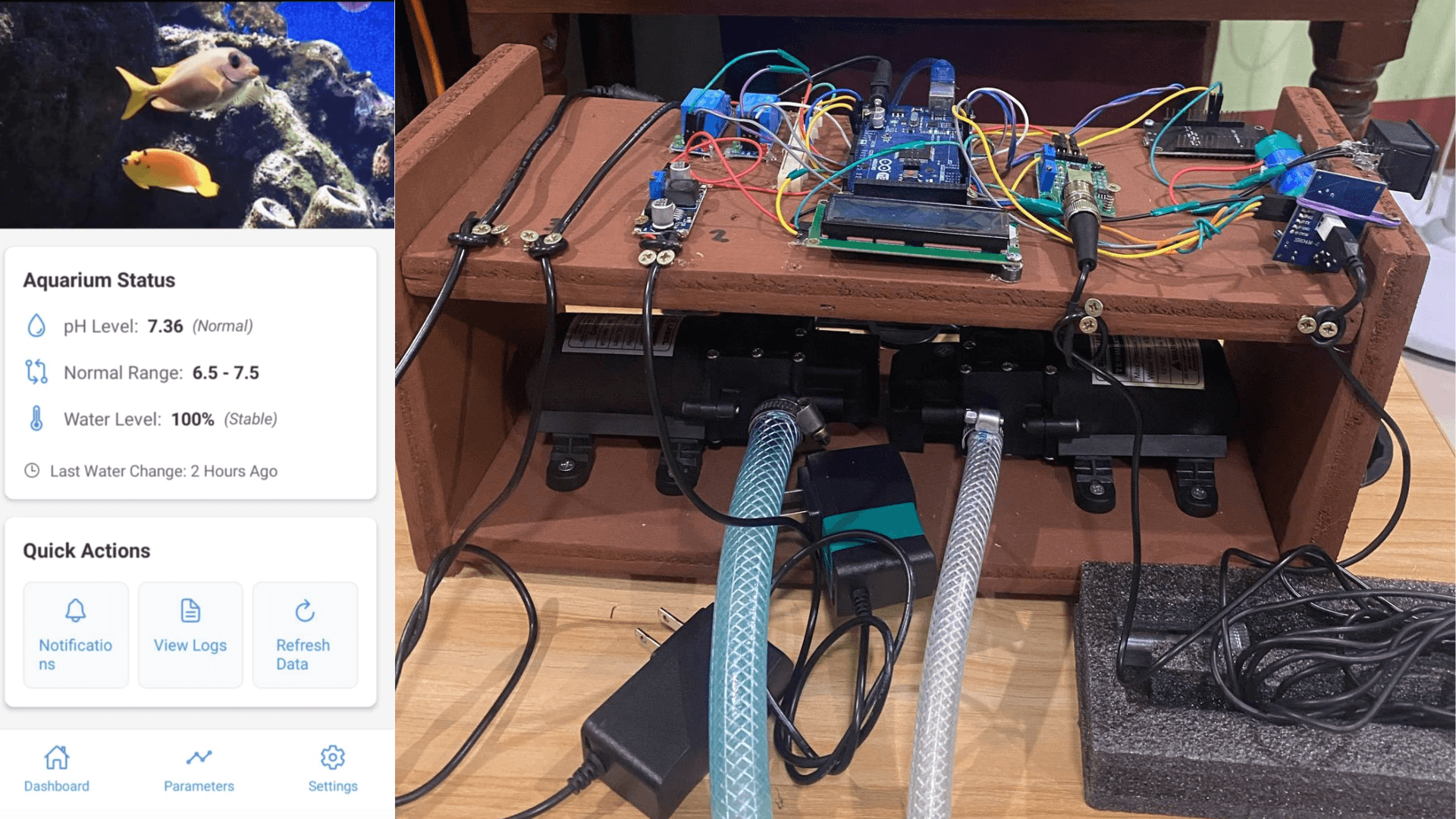
Building My Smart Aquarium
March 19, 2025
Hardware Components
Building a smart aquarium controller requires careful selection of hardware components to ensure reliable operation and accurate monitoring. Here's the detailed hardware stack I used:
Core Components
Arduino Mega
Arduino Mega is the main controller that manages the entire system. It processes data from the pH sensor and ultrasonic sensor, makes decisions based on the readings, and controls the two water pumps through the relay module. With its large number of pins and memory, it's perfect for handling multiple sensors and modules at once.
The Arduino runs custom C++ firmware that handles:
- Real-time sensor reading and data processing
- Actuator control based on sensor readings
- Communication with the ESP8266 module
- System state management and error handling
PH-4502C pH Sensor
A sensor that monitors the pH level of your aquarium water in real time. It detects if the water is too acidic or too alkaline, which could harm your fish. The sensor sends this data to the Arduino, which then decides whether to activate the water change process. Regular cleaning and calibration help maintain its accuracy.
LCD with I2C 1602
This is a small digital display that shows important information such as the current pH level and system status. The I2C interface simplifies wiring, using only two communication lines. This makes it easy to keep track of what's happening in your aquarium without needing to check the mobile app.
JSN-SR04M-2 Ultrasonic Sensor
A waterproof sensor is used to measure the water level in your aquarium. It sends out ultrasonic pulses and measures the time it takes for them to bounce back from the water surface. This helps ensure the system doesn't overflow the tank.
ESP8266 Wi-Fi Module
The ESP8266 allows your system to connect to Wi-Fi and communicate with your mobile app. It sends real-time pH data and water level data to Firebase and then it's being sent to your mobile app, allowing you to monitor the aquarium remotely.
Water Pump (x2)
There are two pumps in the system: one for draining dirty water and one for filling clean water into the aquarium. These pumps are controlled automatically by the Arduino via the relay module, based on the pH level and water level readings.
Buck Converter
This module adjusts and regulates voltage from the power supply to match the requirements of different components, such as stepping down 9V to 5V or 3.3V. It ensures each device gets safe and stable power, helping to prevent overheating or damage.
Relay Module
The relay module acts like a smart switch that allows the Arduino to control high-power components, such as the water pumps. When the Arduino sends a signal, the relay either turns a pump on or off. Each relay channel is connected to one of the two pumps, enabling separate control for draining and refilling.
Power Supply
This provides the necessary electricity to run all components in the system. It powers the Arduino, sensors, pumps, and the Wi-Fi module. A reliable power source is essential for keeping the system stable and operational 24/7.
Software Architecture
The software architecture of the smart aquarium controller is designed for reliability and ease of maintenance. Here's how it all works together:
Core Features
- Real-time monitoring of water parameters
- Automated dosing of water treatments
- Smart lighting control based on time and plant needs
- Remote monitoring via mobile app
- Automated water change system
- Alert system for parameter deviations
Technical Implementation
- Mobile App: React Native application for iOS and Android, providing a user-friendly interface for monitoring and control
- Backend: Python-based control system running on Raspberry Pi
- Database: SQLite for local data storage
- API: RESTful API for remote access
- MQTT: For real-time sensor data transmission
Automation Logic
The system uses a rule-based engine to make decisions about:
- When to dose water treatments
- How to adjust lighting schedules
- When to perform water changes
- Alert thresholds for various parameters
Data Collection
- Sensor readings are collected every 5 minutes
- Data is stored locally and can be exported
- Historical trends are visualized in the mobile app
- Automated reports are generated daily
Security Features
- Encrypted communication
- User authentication
- Secure API endpoints
- Regular backup system
Future Improvements
The system is constantly evolving, with several planned improvements:
- Machine learning for predictive maintenance
- Integration with smart home systems
- Enhanced mobile app features
- Additional sensor support
- Improved automation capabilities
Conclusion
Building this smart aquarium controller has been an exciting journey in IoT development. The combination of Arduino for hardware control and React Native for the mobile interface has created a robust system that makes aquarium maintenance much more manageable. The project demonstrates how modern technology can be applied to improve traditional hobbies and make them more accessible to busy enthusiasts.
Feel free to check out the project on my GitHub repository for more details and setup instructions.
– Va-ay